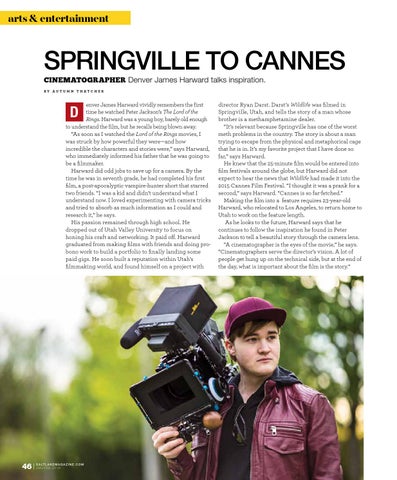arts & entertainment
SPRINGVILLE TO CANNES CINEMATOGRAPHER Denver James Harward talks inspiration. BY AUTUMN THATCHER
enver James Harward vividly remembers the first time he watched Peter Jackson’s The Lord of the Rings. Harward was a young boy, barely old enough to understand the film, but he recalls being blown away. “As soon as I watched the Lord of the Rings movies, I was struck by how powerful they were—and how incredible the characters and stories were,” says Harward, who immediately informed his father that he was going to be a filmmaker. Harward did odd jobs to save up for a camera. By the time he was in seventh grade, he had completed his first film, a post-apocalyptic vampire-hunter short that starred two friends. “I was a kid and didn’t understand what I understand now. I loved experimenting with camera tricks and tried to absorb as much information as I could and research it,” he says. His passion remained through high school. He dropped out of Utah Valley University to focus on honing his craft and networking. It paid off. Harward graduated from making films with friends and doing probono work to build a portfolio to finally landing some paid gigs. He soon built a reputation within Utah’s filmmaking world, and found himself on a project with
D
46
S A LT L A K E M A G A Z I N E . C O M JAN/FEB 2016
director Ryan Darst. Darst’s Wildlife was filmed in Springville, Utah, and tells the story of a man whose brother is a methamphetamine dealer. “It’s relevant because Springville has one of the worst meth problems in the country. The story is about a man trying to escape from the physical and metaphorical cage that he is in. It’s my favorite project that I have done so far,” says Harward. He knew that the 25-minute film would be entered into film festivals around the globe, but Harward did not expect to hear the news that Wildlife had made it into the 2015 Cannes Film Festival. “I thought it was a prank for a second,” says Harward. “Cannes is so far-fetched.” Making the film into a feature requires 23-year-old Harward, who relocated to Los Angeles, to return home to Utah to work on the feature length. As he looks to the future, Harward says that he continues to follow the inspiration he found in Peter Jackson to tell a beautiful story through the camera lens. “A cinematographer is the eyes of the movie,” he says. “Cinematographers serve the director’s vision. A lot of people get hung up on the technical side, but at the end of the day, what is important about the film is the story.”
